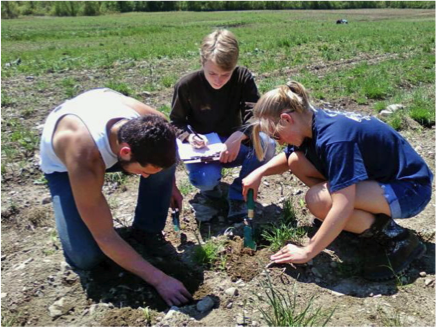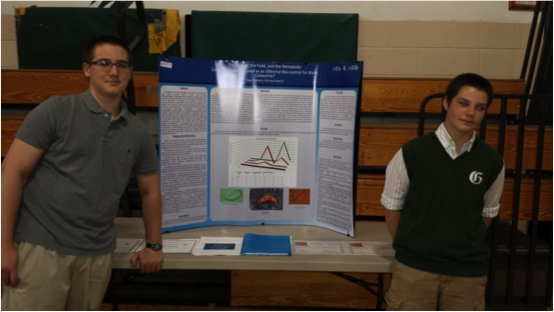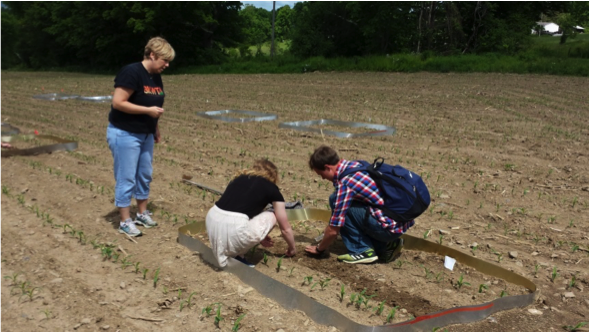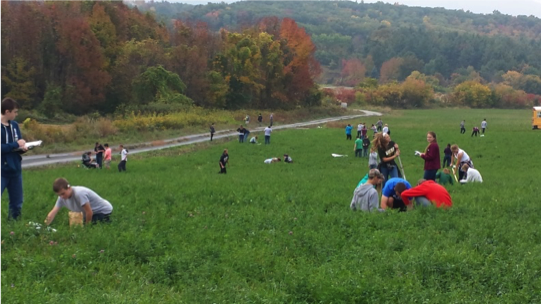Aaron Gabriel, Senior Extension Educator, Cornell Cooperative Extension, Capital Area Agriculture & Horticulture Program
Over the last three years, I have been developing a partnership with high schools to have their students participate in my research projects. It started out with my interest in black cutworm. As I scouted corn fields, many of the skips were not due to rocks or soil conditions, as farmers often assume. Black cutworm frequently was the culprit (as well as birds). To collect enough data to support my observation, would take a lot of time for one person. So, I developed a protocol for determining the cause of skips in corn and contacted several high schools to see if they wanted their students to participate in field research. I found interest at Berne/Knox/Westerlo (BKW), Greenwich, Salem, New Lebanon, and Taconic Hills High Schools. I also found interest from a 4-H club in Columbia County and one Master Gardener.
It just so happens that there is a nation-wide effort to engage students in STEM (science, technology, engineering, and math). The desire to engage students in a research experience and the need for Cooperative Extensions to do research is coming together into a successful partnership. To obtain financial support, grant writing has taken a new perspective. I received two small grants from regional foundations, not to study the pedestrian black cutworm, or nematodes (which have been studied for many years), but to give students a research experience by involving them in relevant local Cooperative Extension research. The program objectives focus on the students and on helping the local agricultural community, not on solving a specific agricultural problem.
Program Objectives:
- Develop a 4-session high school curriculum to give students a real-world research experience that will:
- Teach students how to conduct and interpret research.
- Help students recognize their interest and potential in pursuing careers in science and research.
- Teach students how to critically evaluate research that is broadcast through news media.
- Conduct agricultural research that will:
- Provide useful information that CUCE can extend to farmers for positive impacts.
- Give students an experience to help them better understand agricultural.
- Teach students the impact that research has on the community.
My first collaboration was with a class of BKW Advanced Placement Biology students in late May, 2012. Having taken their last exam in mid-May, like all AP Biology students in New York, they needed some projects until the end of the year in mid-June. First, I gave them a presentation in class to explain the dilemma of missing corn plants and my interest in the black cutworm (BCW). I armed them with a data collection sheet, tools, and pictures of the insects, bugs, and diseases they might find digging in a corn field looking for the culprits that cause skips in corn. The first field we sampled was an early-planted corn following sod. The seed had a low dose of seed-applied insecticide. The sod and weeds had not yet been sprayed with herbicide. There were many missing corn plants. To my surprise, at most of the skips they were finding seedcorn maggot pupae. We learned that at high pressure, the low-dose of seed-applied insecticide did not provide protection. The corn population was reduced by 23% to 21,017 plants/acre, with 30% of the skips due to seedcorn maggot. Seedcorn maggot was not as severe in other fields.

Currently, I am doing research to learn how to use beneficial nematodes to control insect pests in corn (grubs, black cutworm, and corn rootworm). Two students helped me by doing a bioassay in the lab to confirm that our nematodes would infect BCW. They entitled their project, “The Farmer, the Field, and the Nematode”, entered it into the Greater Capital Region Science and Engineering Fair and won the environmental award.

With confidence that these nematodes (from the lab of Dr. Eslon Shields, Cornell Univ.) will infect black cutworm, plots were set up to evaluate their effectiveness on BCW in the field. Plots 5’ X 7” were treated with either nematodes or water, as a control, and then infested with purchased BCW. Fields were located in Salem and Berne. AP Biology students from the local schools helped infest the plots and collect data to compare the damage from the two treatments. Nematodes did kill some of the BCW, but damage between the two treatments was similar.

As I was trying to figure a new way to get the nematodes established in a field before the corn crop, Donna McGovern, BKW teacher, asked if I had a project for her entire class of ninth-grade biology students. We developed a plan to apply the nematodes to a white grub-infested hay field before it would be planted to corn. So, 52 biology students sampled 160 locations and collected and tallied up the white grubs in two fields. On my own, I could never sample the grub population like that. Nematodes were applied and corn will be planted in the spring. This time, some plots will be infested with BCW, and others with corn rootworm. The students will be there to collect the data on BCW damage. Since rootworm damage is evaluated in July, I will need to find a 4-H club to help, or students that want an education outside of the school year.

Students have also performed lab bioassay experiments and determined that nematodes will not survive in pop-up fertilizer, unless it is diluted with 50% water. The purpose is to evaluate other methods of applying nematodes (which are suspended in water). New Lebanon students determined that our nematodes do not infect fly larvae, like the seedcorn maggot. These fairly simple experiments give students a real research experience and help me generate the information I need as a CCE educator to help local farmers.
The next step of the CCE / School Research Partnership is to complete development of a 4-session curriculum that can be used by any pair of Extension Educator and school teacher. This is currently underway where students will learn how to research a topic, formulate a hypothesis, design an experiment, do the experiment, analyze the data and make conclusions. The finale of the curriculum will be to visit a local farm and learn how research has shaped agriculture and how it impacts farmers.

